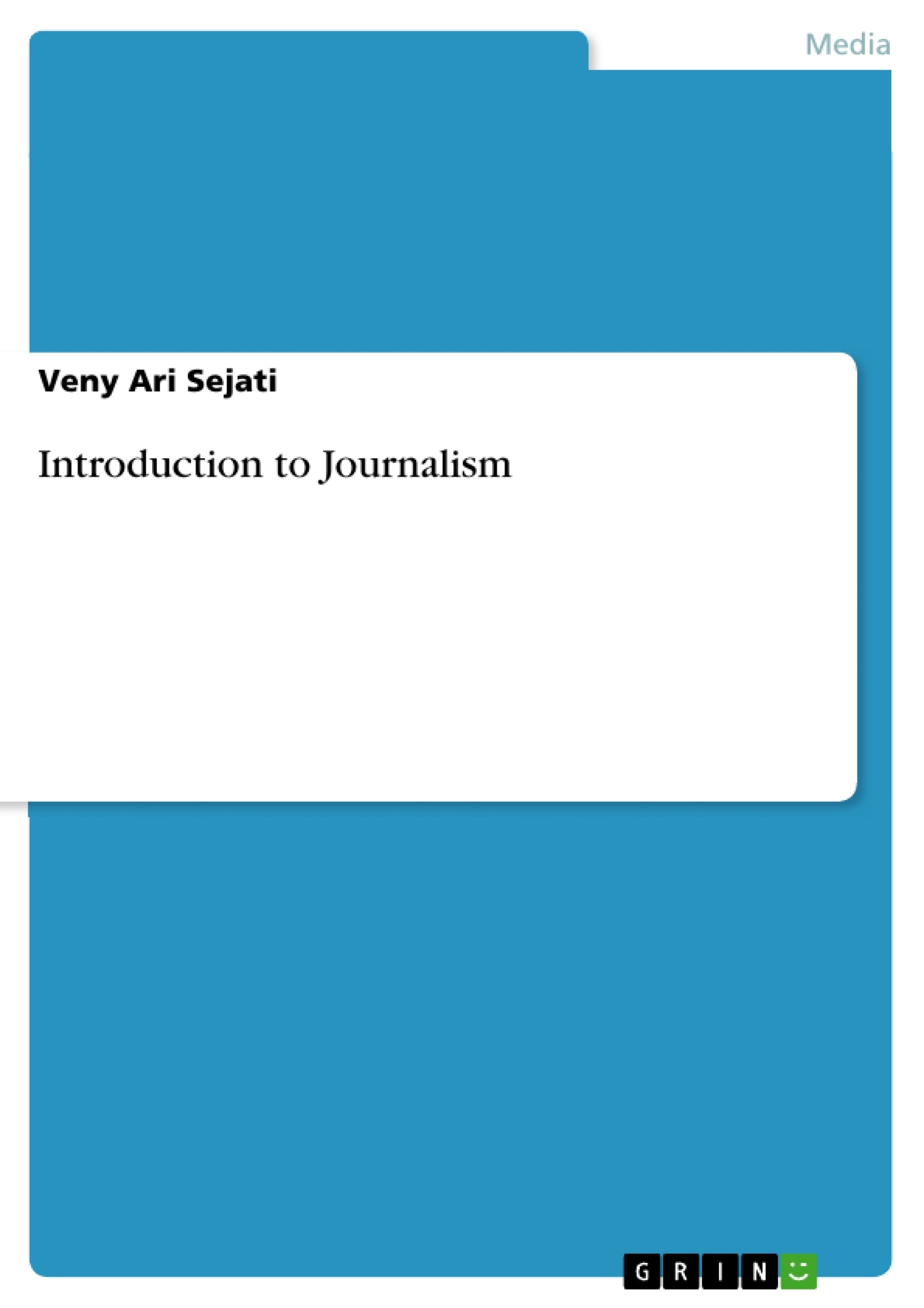Basically, the whole field of work requires the science and skills of journalism so that the audience, consumers, clients, feel interested and confident about what we serve through the writing and help us achieve the goal. Written communication using grammar based on rules journalism could avoid misunderstanding in communication. This book uses Jurnalistik, Pendekatan Teori dan Praktek by Asep Saeful Muhtadi as main reference and other books as supported references.
Table of Contents
- PART 1. JOURNALISM
- Understanding Journalism
- Medium Journalism
- What is Journalism Language
- Summary
- Review Questions
- PART 2. PRESS
- Understanding the Press
- Visual Press Elements
- Summary
- Review Questions
- PART 3. NEWS
- What is News?
- Straight News
- Feature
- News Variety
- News Construction
- News Elements
- News Search Techniques
- News framing
- Summary
- Review Questions
- PART 4. INTERVIEW
- What is Interview?
- Interview guidelines
- What is Off the Record?
- Conventional Ethics
- Statistics Interpretation
- Summary
- Review Questions
Objectives and Key Themes
This book aims to provide students and professionals with a foundational understanding of journalism, encompassing its principles, practices, and ethical considerations. It seeks to equip readers with the necessary skills for effective communication within various professional contexts.
- The fundamentals of journalism and its role in communication.
- The nature of news, its construction, and various forms.
- Effective interviewing techniques and ethical considerations.
- Understanding the press and its visual elements.
- The importance of clear and concise language in journalistic writing.
Chapter Summaries
PART 1. JOURNALISM: This section lays the groundwork for understanding journalism as a discipline. It likely explores the core principles of journalistic integrity, accuracy, and objectivity. It possibly delves into different approaches to journalistic practice, defining the field and its significance in society, perhaps touching upon the historical development of journalism and its role in informing the public. The importance of ethical considerations would likely be a crucial element.
PART 2. PRESS: This part likely focuses on the role and function of the press as an institution. It probably explores the different types of media outlets, analyzing their influence and responsibilities in disseminating information. The section might delve into the visual aspects of journalism, discussing the importance of imagery and its impact on news consumption and public perception. The relationship between the press and the public, alongside ethical considerations, would likely be key themes.
PART 3. NEWS: This substantial section delves into the multifaceted nature of news, encompassing its definition, various forms (straight news, feature articles), construction processes, and critical elements. It probably covers how news is researched, framed, and presented to the audience, including exploring different journalistic styles and approaches to storytelling. The section likely emphasizes the significance of accuracy, objectivity, and ethical considerations in news reporting.
PART 4. INTERVIEW: This section focuses on the crucial journalistic skill of conducting interviews. It likely covers various interviewing techniques, guidelines for effective questioning, and the importance of ethical considerations like "off the record" agreements. It probably explores how to approach interviews with different individuals and in different contexts, perhaps touching upon the critical skill of interpreting statistical data within an interview setting.
Keywords
Journalism, Press, News, Interview, Communication, Media, Ethics, Reporting, Accuracy, Objectivity, Language, Visual elements, News framing, Interview techniques, Statistical Interpretation.
FAQ: Comprehensive Language Preview of Journalism, Press, News, and Interview
What is the overall purpose of this book?
This book aims to provide a foundational understanding of journalism, its principles, practices, and ethical considerations. It equips readers with skills for effective communication in various professional contexts.
What topics are covered in Part 1: Journalism?
Part 1 lays the groundwork for understanding journalism as a discipline. It covers core principles like integrity, accuracy, and objectivity, different journalistic practices, and the historical development and societal role of journalism. Ethical considerations are a crucial element.
What topics are covered in Part 2: Press?
Part 2 focuses on the role and function of the press as an institution. It explores different media outlets, their influence and responsibilities, and the visual aspects of journalism, including the impact of imagery on news consumption. The relationship between the press and the public, along with ethical considerations, are key themes.
What topics are covered in Part 3: News?
Part 3 delves into the multifaceted nature of news, including its definition, various forms (straight news, features), construction processes, and critical elements. It covers news research, framing, presentation, journalistic styles, and the importance of accuracy, objectivity, and ethics in news reporting.
What topics are covered in Part 4: Interview?
Part 4 focuses on interviewing techniques, guidelines for effective questioning, ethical considerations like "off the record" agreements, and approaches to interviewing different individuals in various contexts. Interpreting statistical data within interviews is also addressed.
What are the key themes of the book?
Key themes include the fundamentals of journalism and its role in communication; the nature of news, its construction, and various forms; effective interviewing techniques and ethical considerations; understanding the press and its visual elements; and the importance of clear and concise language in journalistic writing.
What are the key words associated with this book?
Key words include: Journalism, Press, News, Interview, Communication, Media, Ethics, Reporting, Accuracy, Objectivity, Language, Visual elements, News framing, Interview techniques, Statistical Interpretation.
What is included in the Table of Contents?
The Table of Contents details the structure of the book, outlining the four main parts: Journalism, Press, News, and Interview. Each part is further divided into specific chapters, including summaries and review questions.
What kind of audience is this book intended for?
This book is intended for both students and professionals seeking a foundational understanding of journalism.
Where can I find chapter summaries?
Detailed summaries for each of the four parts (Journalism, Press, News, and Interview) are provided in the book preview.
- Quote paper
- Veny Ari Sejati (Author), 2018, Introduction to Journalism, Munich, GRIN Verlag, https://www.grin.com/document/432905




